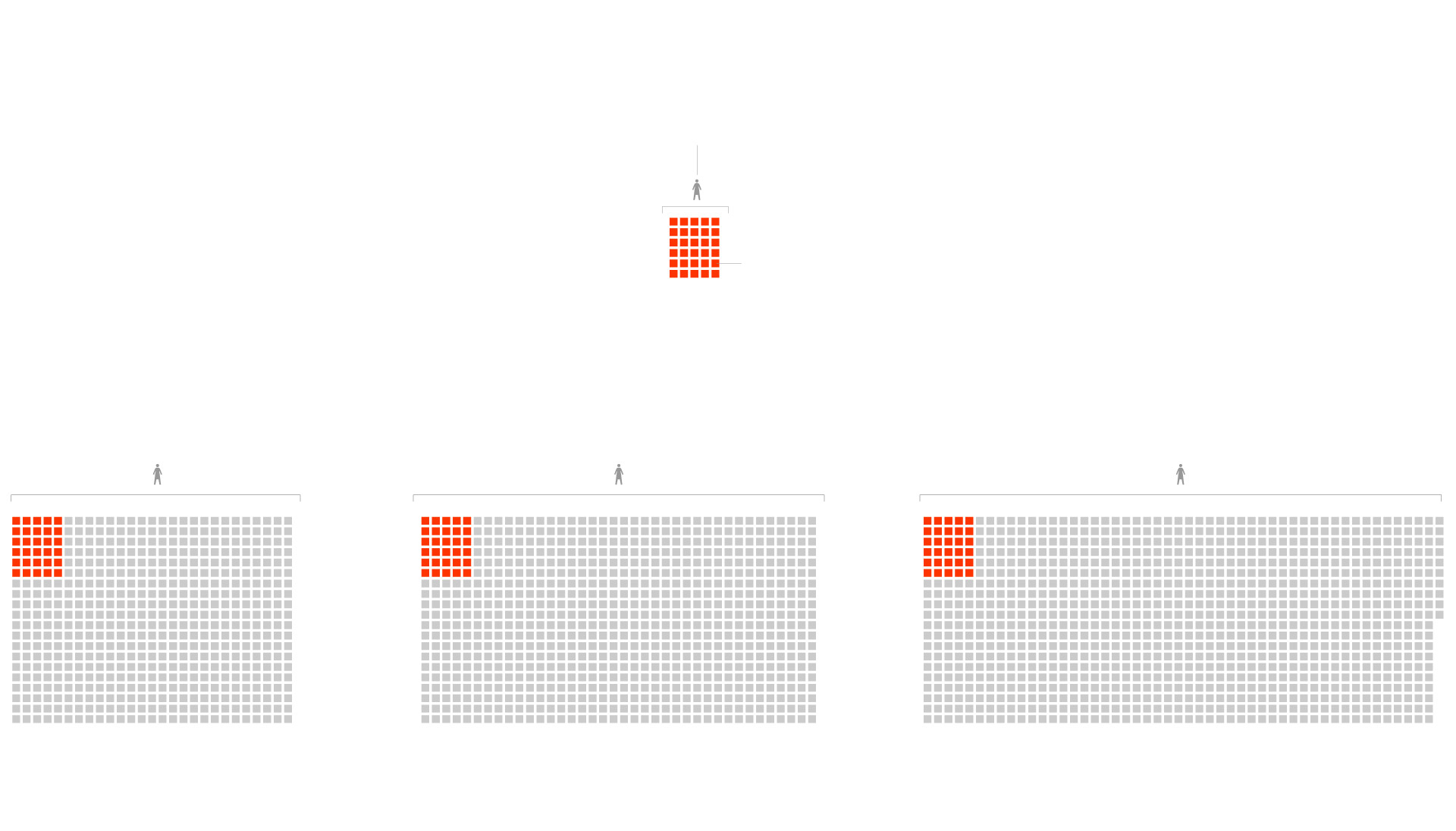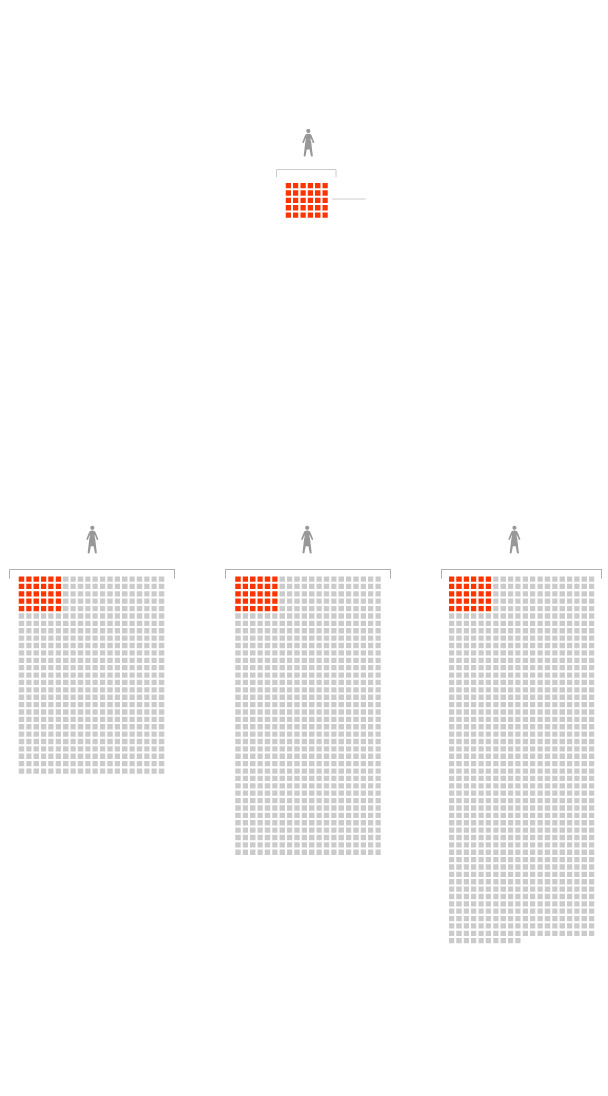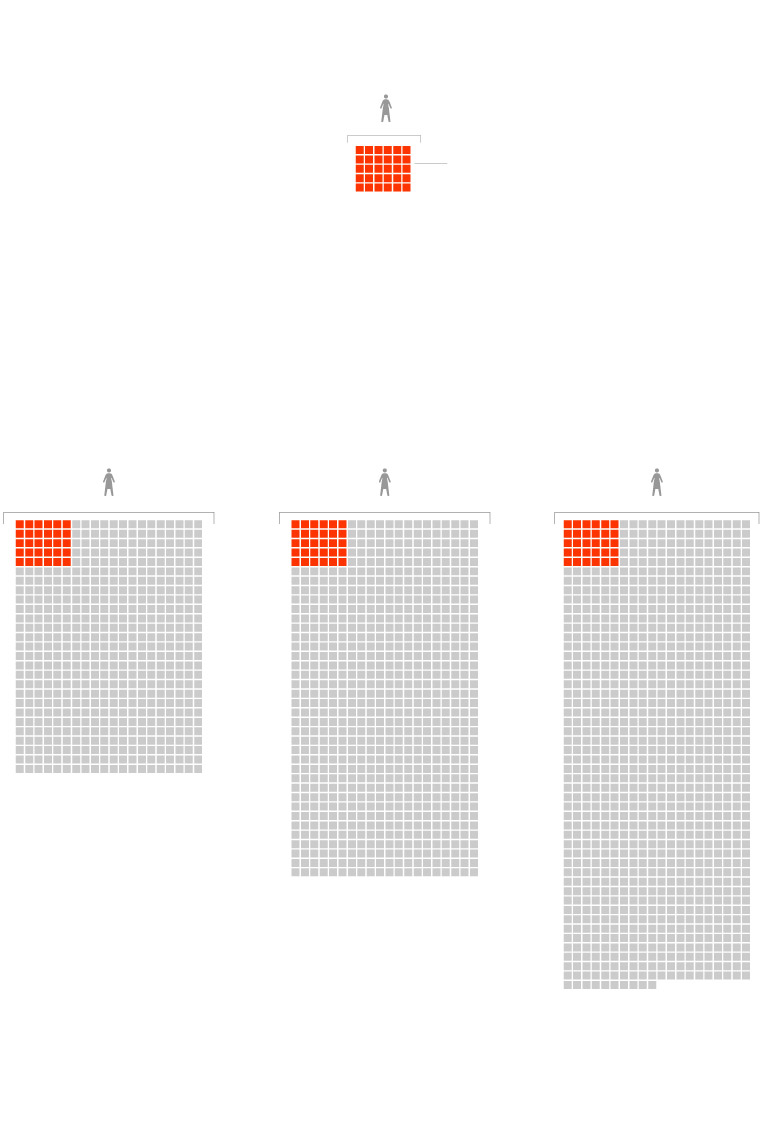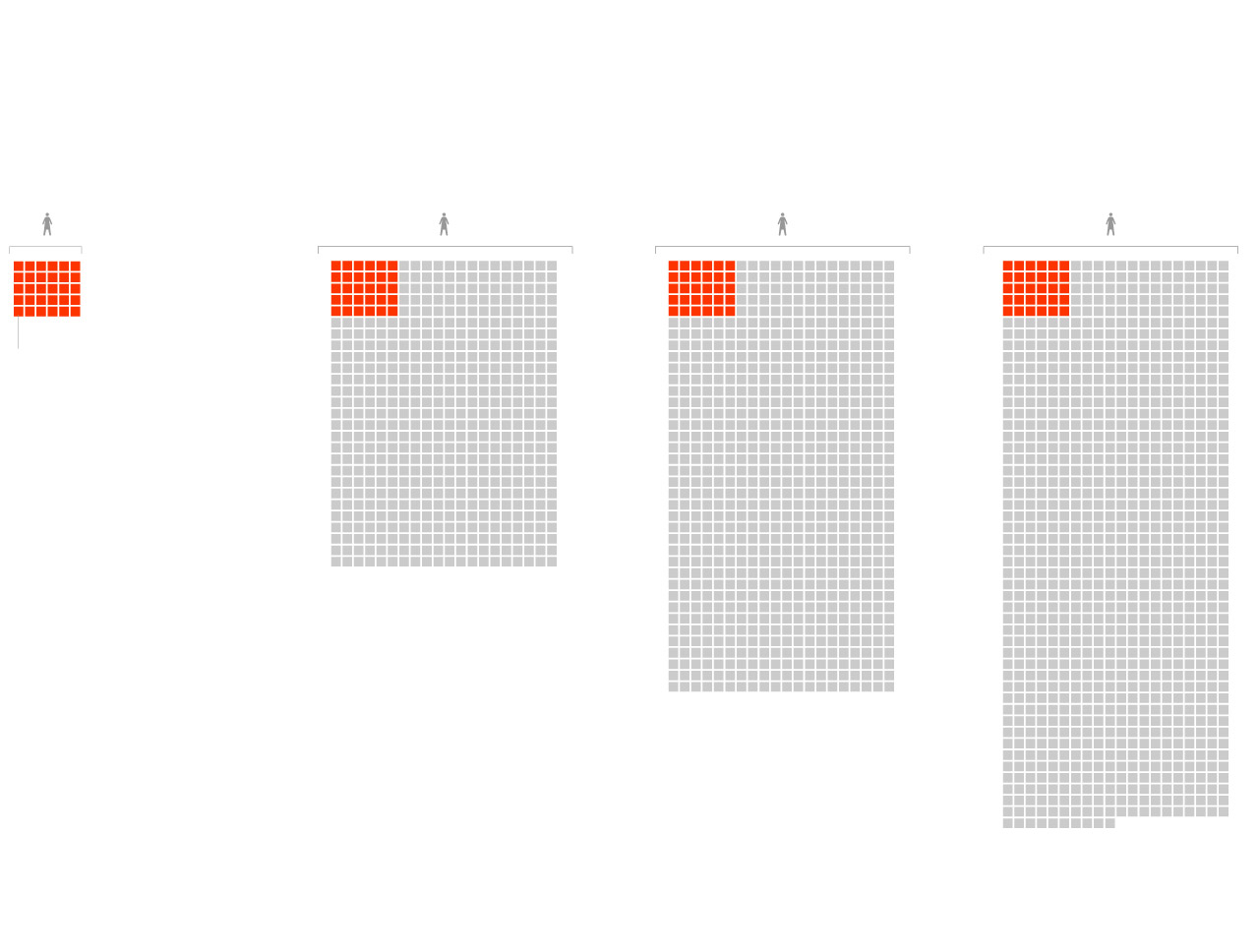OpinionCan the Capitol hold a much bigger House? Yes, here’s how it would look.
In recent installments of my series on renovating our democracy, I have argued that increasing the size of the U.S. House of Representatives can help us achieve more inclusive, responsive and energetic governance while reconnecting members to their constituents. This is the change we need first and foremost — many other important changes will flow from it.
Growing the House, in today’s broken-down politics, might seem absurd or unfeasible, but it has plenty of precedent. And a closer connection between representatives and constituents was envisioned by the Founders as a vital design principle of our system. During the Constitutional Convention, George Washington himself endorsed an amendment that would set a ratio of one representative per 30,000 constituents. Here is how Washington’s proposal compares with today’s reality:

Proposal backed
by Washington
One representative
for 30,000 people
Each square equals 1,000 people.
Current ratios in a few states
Delaware
1 for 990,000 people
Montana
1 for 540,000 people
CALIFORNIA
1 for 760,000 people
Highest ratio of all states
This ratio is about the U.S. average
Lowest ratio of all states
Source: Census Bureau
A system requiring one person to represent the interests of almost 1 million people would have troubled Washington — as it should us. But let’s set his ratio aside for a moment. In a previous column, I argued for a bill put forward by Rep. Earl Blumenauer (D-Ore.) that would bring us to 585 seats. And after that initial step up, we could transition to “a cube root rule” — pegging the number of House members to the cube root of the national population — for growth in subsequent census years. In this way, the size of the House would increase continually with the population but at a steady and manageable rate. Based on population projections, this would put us on track for a Congress that would grow from 435 to 585 to 736 over the next 40 years.
But what would happen to the Capitol? Wouldn’t we need a new building? Doesn’t that make this impossible?
The Capitol has already undergone multiple extensions. In 1850, growth in membership led to a major renovation project. By 1869, the work delivered the Capitol that we know now. But even after the Capitol was complete that year, the House continued to grow. In the 1870s, it grew from 243 to 293 members, continuing up to the current 435, established in 1929.
LEFT: The House of Representatives before its expansion in 1913. (Library of Congress) RIGHT: The 1913 renovation marked the end of members using the chamber as their primary work space. (Collection of the U.S. House of Representatives)
And here’s the extraordinary thing: It still has room for more growth — quite a bit of it.
I engaged architect Michael Murphy to explore what is possible. Murphy is a visionary designer committed to architecture for the public good. He designed Bryan Stevenson’s National Memorial for Peace and Justice — the memorial for lynching and racial violence victims, as it’s better known — in Montgomery, Ala.
(Ethan Alexander Rainbolt)
(Ethan Alexander Rainbolt)
(Ethan Alexander Rainbolt)
Murphy and his team took the current dimensions of the House and halls, shown in this image, as a starting point.
The chamber now comfortably accommodates about 450 people on the floor, along with more than 400 in the gallery on the second level.
The team’s first idea was to create a new elevated section that could easily allow seating for up to 904 members.
This image shows the speaker’s point of view. Consistency with the existing chamber aesthetics would probably make this scheme less contentious, making it more likely to gain wide support.
“This is a very simple approach to expanding the space. It maintains the existing look and basic operation of the space,” explained New York-based artist and architectural designer Samuel Stubblefield, who collaborated on the visualizations. “The addition of a mezzanine becomes an extension of the existing floor.”
(Ethan Alexander Rainbolt)
(Ethan Alexander Rainbolt)
(Ethan Alexander Rainbolt)
In another study, the team rearranged the seating in a circular fashion, putting the speaker’s position in the center.
This arrangement would allow seating for up to 1,060 people.
The architects placed the speaker at the lowest point in the room — to communicate a democratic, egalitarian message in a country whose founding ethos involved the questioning of aristocracy and titles.
More than that, moving away from a pulpit-style arrangement would change the dynamic of the room. “The ‘in the round’ format, which presidents like George W. Bush and Obama often utilized, provides a more conversational format and shows members together performing witness,” Murphy said.
(Ethan Alexander Rainbolt)
(Ethan Alexander Rainbolt)
(Ethan Alexander Rainbolt)
To my surprise and delight, the team’s last proposal reveals that we could actually take the House of Representatives up to 1,725 members without having to construct a new building.
A circular mezzanine mirrors the geometry of the main floor to better tie the two levels together in a single, integrated space.
This is a view from the mezzanine. Remaining space on the second level could be used to accommodate visitors, conference rooms and news organizations.
These studies show that it’s physically feasible to substantially grow the chamber. But it’s true that it can only grow so big. If we went with George Washington’s proposal of one representative per 30,000 residents, today’s 435 House members would become 11,063, with districts ranging from the size of a neighborhood in New York City to substantial parts of a state in sparsely populated regions.
I’ll be honest: I used to think the idea of a House of Representatives that large was crazy. But new artificial intelligence tools might actually make it necessary. Proximity this close between representatives and constituents might turn out to be the only antidote to the problem of misinformation. There’s good news here, too, however. Technology could not only bring about a need for this; it might also deliver the tools for us to succeed at it.
Just as I reached out to an architect to think about the physical space in the Capitol, I reached out to a team of information architects, Ethan Zuckerman and Chand Rajendra-Nicolucci, both at the University of Massachusetts Initiative for Digital Public Infrastructure. They believe 11,000 is possible and explained how.
In keeping with the collaborative spirit of this project, let me quote them at length:
Zuckerman and Rajendra-Nicolucci write: “Rather than reconfiguring the Capital One Arena to host Congress when the Wizards are out of town, Congresspeople in this ‘Big House’ would have home offices in their district, but conduct their legislative, investigative, and deliberative work online, as many of us have grown used to doing. While the task of virtualizing Congress sounds daunting, in a sense, it’s not entirely different from the challenges large corporations have faced coordinating workflow between different offices. Asking Congress to work using Microsoft Teams or Google Workspace may not be a viable option, but it’s a good starting point for information architects thinking about a Congress of over 11 thousand members.
“This expanded Congress will need a workplace platform that allows committees to discuss and draft legislation, conduct investigations, and carry out the legislative business it has been charged with since 1789.”
It could draft legislation using tools similar to Google Docs, where different users can add comments and work at the same time.
“A very online Congress is likely to look a little like Reddit — a vast array of conversations focused on an impossible variety of topics, all of them fascinating to someone, not all of them fascinating to you.

Below, a mock-up of a forum where constituents could participate in the legislative process, inspired by Reddit.
Sample of constituent commentary
Janet Doe
Constituent
5 hours ago
The problem with the bill right now is that it ignores the possible effect on the people who live in my part of the district and other places like it – I know several people who are worried about it. I honestly don’t think that’s what the authors intend, but it could still cause headaches...
the courts later. Could language be added to address that? It wouldn’t change the cost or overall effectiveness to protect against unintended consequence.
2.8K
Reply
Share
Joe Doe
Constituent
5 hours ago
That’s a good point. We should scrutinize the bill for other things like that before going any further. It’s worth taking the time now to get it right, and I think it would help to build more support. I appreciate this constructive criticism. Do others have similar ... ...concerns?
2.8K
Reply
Share
1,200 more replies
972 more replies
Users could up-vote and reply to other users
and legislators.

Below, a mock-up of a forum where constituents could participate in the legislative process, inspired by Reddit.
Sample of constituent
commentary
Janet Doe
Constituent
5 hours ago
The problem with the bill right now is that it ignores the possible effect on the people who live in my part of the district and other places like it – I know several people who are worried about it. I honestly don’t think that’s what the authors intend, but it could still cause headaches and even issues in the courts later. Could language be added to address that?
2.8K
Reply
Share
Joe Doe
Constituent
5 hours ago
That’s a good point. We should scrutinize the bill for other things like that before going any further. It’s worth taking the time now to get it right, and I think it would help to build more support. I appreciate this constructive criticism. Do others have similar concerns?
2.8K
Reply
Share
1,200 more replies
972 more replies
Users could up-vote and reply
to other users and legislators.

Below, a mock-up of a forum where constituents could participate in the legislative process, inspired by Reddit.
Janet Doe
Constituent
Sample of constituent commentary
5 hours ago
The problem with the bill right now is that it ignores the possible effect on the people who live in my part of the district and other places like it – I know several people who are worried about it. I honestly don’t think that’s what the authors intend, but it could still cause headaches and even issues in the courts later. Could language be added to address that? It wouldn’t change the cost or overall effectiveness to protect against unintended consequence.
2.8K
Reply
Share
Joe Doe
Constituent
5 hours ago
That’s a good point. We should scrutinize the bill for other things like that before going any further. It’s worth taking the time now to get it right, and I think it would help to build more support. I appreciate this constructive criticism. Do others have similar concerns?
2.8K
Reply
Share
1,200 more replies
Users could up-vote and reply
to other users and legislators.
972 more replies
“The Reddit analogy has additional importance for Congress as a deliberative space. Our founders saw Congress as a forum in which representatives from around the nation would come into conversation armed with their constituents’ specific views, but capable of being swayed by the arguments of others.
“The major barrier to this plan’s adoption would be the 435 existing Congresspeople agreeing to share their status and power with more than 10,000 new members.”
Zuckerman and Rajendra-Nicolucci have an important point there. Growing the House means remaking the jobs of our representatives. It would force existing members to run for their seats in districts where they don’t already know how to win. The smaller ratio between themselves and constituents would change expectations for the presence and service they deliver. The number and nature of committee assignments would change.
But good managers don’t unilaterally change someone’s job description. They take the time to figure out what frustrations the person has with their job as constituted and what room for improvement they can see. We the people, as the managers who hire our representatives, should do the same.
What do members themselves want to change about their jobs? They have many frustrations. In December, the House Select Committee on the Modernization of Congress released an important report containing a number of recommendations to improve the functioning of Congress and the experience of being a member.
How to renovate American democracy
1/10
Members find it hard to keep and recruit staff. They would like affirmation, reward and support for bipartisanship and collegiality. They, too, need respite from toxicity. They would like flexible and modern office designs and even hearing rooms that would permit a roundtable setting structure, rather than a courtroom style. They are experimenting with technology and apps to improve room booking, bill tracking and digital infrastructure for constituent services. They would like support to succeed at these aspects of their jobs and to master both the promise and peril of technology. They would love the chance to learn about legislative best practices from legislatures elsewhere — both in the states and internationally. They, too, need professional development.
I think all of that is a slam dunk. It’s also all part of the same renovation. Imagining a different kind of Congress, to get a better democracy, goes beyond the physical space it occupies. The right number is not set in stone; neither is the job itself. But this at least is clear: We can make it better to be in Congress, and we can make it better to be represented by Congress.
So let’s get on with it. Change is overdue.


